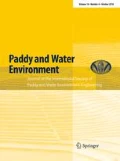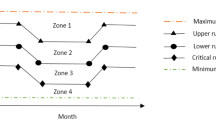Abstract
This study aims to propose a methodology for establishing the optimal rule curves of reservoir operation based on a multi-use reservoir system. Located on the upper Saigon River, Dau Tieng Reservoir plays an important role in economic and social aspects: (1) flood control; (2) domestic and industrial demands; (3) flushing out salt water intrusion from the downstream area; and (4) agriculture irrigation. We propose a reservoir operation model using a constrained genetic algorithm (CGA), in which the fitness function was constrained by penalty functions. The proposed model was formulated by including various water demands configured into the objective function. The penalty functions were designed for various constraints and integrated into the objectives of the operation process to perform the fitness function. The model’s performance was simulated for the last 20 years with 1-month intervals and evaluated through a generalized shortage index (GSI). The derived results of three CGA cases with associated environmental flow requirements significantly improved the efficiency and effectiveness of water supply capability to various water demands as compared to current operation. Among the three cases, CGA case 3 achieved much better water releases from the reservoir as indicated by a small derived GSI value (0.33), the smallest shortage of environmental water (0.11 m3/s) and the highest water usage (63.8 %). Thus, the derived results of CGA case 3 were presented as the best rule curves for reservoir operation. To summarize, CGA was demonstrated as an effective and powerful tool for optimal strategy searching for multi-use reservoir operations.






Similar content being viewed by others
References
Abedian A, Ghiasi MH, Dehghan-Manshadi B (2006) Effect of a linear-exponential penalty function on the GA’s efficiency in optimization of a laminated composite panel. Int J Comput Intell 2(1):5–11
Afshar MH (2012) Large scale reservoir operation by constrained particle swarm optimization algorithms. J Hydro-environment Res 6:75–87
Bauer M, Olsson O (2008) Integration of enhanced reservoir operation (enrop) into IWRM in association with environmental and ecological aspects, In: XIIIth World Water Congress, Montpellier
Cardwell H, Jager HI, Sale MJ (1996) Designing instream flows to satify fish and human water needs. J Water Resour Plan Manag-ASCE 122(5):356–363
Chang LC (2008) Guiding rational reservoir flood operation using penalty-type genetic algorithm. J Hydrol 354:65–74
Chang FJ, Chen L, Chang LC (2005) Optimizing the reservoir operation rule curves by genetic algorithm. Hydrol Process 19(11):2277–2289
Chang LC, Chang FJ, Wang KW, Dai SY (2010) Constrained genetic algorithms for optimizing multi-use reservoir operation. J Hydrol 390:66–74
Chaves P, Chang FJ (2008) Intelligent reservoir operation system based on evolving artificial neural networks. Adv Water Resour 31:926–936
Chen L, Chang FJ (2007) Applying a real-coded multi-population genetic algorithm to multi-reservoir operation. Hydrol Process 21(5):688–698
Chinh LV, Hiramatsu K, Harada M, Mori M (2009) Estimation of water levels in a main drainage canal in a flat low-lying agricultural area using artificial neural network models. Agric Water Manag 96:1332–1338
Chu-Tian C, Ming-Yan Z, Chau KW, Xin-Yu W (2006) Using genetic algorithm and TOPSIS for Xinanjiang model calibration with single procedure. J Hydrol 316:129–140
Deep K, Dipti (2008) A self-organizing migrating genetic algorithm for constrained optimization. Appl Math Comput 198(1):237–250
Gibbins CN, Soulsby C, Jeffries MJ, Acornley R (2001) Developing ecologically acceptable river flow regimes: a case study of Kielder reservoir and the Kielder water transfer system. Fish Manag Ecol 8(6):463–485
Guo SL, Zhang HG, Chen H, Peng DZ, Liu P, Pang B (2004) A reservoir flood forecasting and control system in China. Hydrol Sci J 49(6):959–972
Holland JH (1975) Adaptation in Natural and Artificial systems. The University of Michigan Press, Ann Arbor
Homa ES, Vogel RM, Smith MP, Apse CD, Huber-Lee A, Sieber J (2005) An optimization approach for balancing human and ecological flow needs. In: EWRI 2005, Impacts of Global Climate Change, Proceedings of the 2005 World Water and Environmental Resources Congress, Anchorage, 15–19 May, p 1–12
Hsu SK (1995) Shortage indices for water-resources planning in Taiwan. J Water Resour Plan Manag 121:119–131
Hsu NS, Wei CC (2007) A multipurpose reservoir real-time operation model for flood control during typhoon invasion. J Hydrol 336:282–293
Jager HI, Smith BT (2008) Sustainable reservoir operation: can we generate hydropower and preserve ecosystem values? River Res Appl 24(3):340–342
Katsifarakis KL, Petala Z (2006) Combining genetic algorithms and boundary elements to optimize coastal aquifers’ management. J Hydrol 327(1–2):200–207
Kumar D, Nagesh, Reddy, Janga M (2005) Multipurpose reservoir operation using particle swarm optimization. In: Proceedings of International Conference on Hydrological Perspectives for Sustainable Development, Departmant of Hydrology, IIT, Roorkee, India, Feb 23–25, p 556–564
Li X, Guo S, Liu P, Chen G (2010) Dynamic control of flood limited water level for reservoir operation by considering inflow uncertainly. J Hydrol 391:124–132
MARD: Ministry of Agriculture and Rural Development (1995) Handbook of guiding the reservoir operation rule curves for Dau Tieng reservoir. MARD, Tay Ninh
McCartney MP, Awulachew SB, Seleshi Y, Prasad K, King J, Tarekegn D (2005) Decision support systems for dam planning and operation in Africa. In: International Water Management Institute, Colombo, Sri Lanka (IWMI Working Paper 119)
MONRE: Ministry of Natural Resources and Environment (2009) Climate change and sea level rise for Vietnam. MONRE, Hanoi
Ngoc TA: Mathematical modeling for optimal operation of multi-use Dau Tieng Reservoir, Tay Ninh, Vietnam. Msc Thesis (2012)
Ngoc TA, Chinh LV, Hiramatsu K, Harada M (2011) Parameter identification for two conceptual hydrological models of upper Dau Tieng River watershed in Vietnam. J Fac Agric, Kyushu University 56(2):335–341
Ngoc TA, Hiramatsu K, Harada M (2013) Optimizing parameters for two conceptual hydrological models using a genetic algorithm: a case study in the Dau Tieng River watershed, Vietnam. Japan Agric Res Q 47(1):85–96
Papaioannou G, Vouraki K, Kerkides P (1996) Piche evaporimeter data as a substitute for Penman equation’s aerodynamic term. Agric For Meteorol 82(1–4):83–92
Stanhill G (1962) The use of the Piche evaporimeter in the calculation of evaporation. Q J Royal Meteorol Soc 88(375):80–82
Suen JP, Eheart JW (2006) Reservoir management to balance ecosystem and human needs: incorporating the paradigm of the ecological flow regime. Water Resour Res 42:W03417
Wei CC, Hsu NS (2009) Optimal tree-based release rules for real-time flood control operations on a multipurpose multi-reservoir system. J Hydrol 365:213–224
Yin XA, Yang ZF (2011) Development of a coupled reservoir operation and water diversion model: Balancing human and environmental flow requirements. Ecol Model 222(2):224–231
Acknowledgments
The authors greatly appreciate the support under FY2012-2014 JSPS Core-to-Core Program “Collaborative Project for Soil and Water Conservation in Southeast Asian Watersheds” and FY2011-2015 JSPS Grant-in-Aid for Scientific Research (B) (Project number: 23380144).
Author information
Authors and Affiliations
Corresponding author
Rights and permissions
About this article
Cite this article
Ngoc, T.A., Hiramatsu, K. & Harada, M. Optimizing the rule curves of multi-use reservoir operation using a genetic algorithm with a penalty strategy. Paddy Water Environ 12, 125–137 (2014). https://doi.org/10.1007/s10333-013-0366-2
Received:
Revised:
Accepted:
Published:
Issue Date:
DOI: https://doi.org/10.1007/s10333-013-0366-2




